Seventeen Mile Grade is a steep section of track on the Mountain Subdivision of 17 miles
in length, hence its name, between the summit at Altamont and the small town of Piedmont
at the base of Backbone Mountain. As C.S. Roberts points out in his book the "West
End", the hard part of mountain railroading is not going uphill because enough power
can always be applied, but going downhill because most trains are terribly hard to slow
down once they get moving. With most of the Mountain Subdivision's total tonnage moving
east to Cumberland, it all has to be moved down Backbone Mountain which happens to rank
among the top worst descending grades on the Eastern Seaboard. To illustrate how steep 17
Mile Grade is, once upon a time well into the CSX era an eastbound coal drag was
descending the grade when it was forced to make an emergency application of its air brakes
due to a mechanical failure. On most railroad lines an emergency application would
immediately stop the train and prevent it from moving until the brakes were released, but
Seventeen Mile is something entirely different. With both the airbrakes applied throughout
the train's eighty cars and the locomotive brakes engaged, the coal drag was still slowly
drifting down Backbone Mountain until the train's crew tied down enough handbrakes to
completely stop it! Eastbound trains begin the journey down 17 Mile Grade to Piedmont just
past the Maryland State Rt 135 Road Bridge at Altamont. To the north of the current two
tracks was a large wye which was used to turn steam power until the 1950s, when
dieselization made this practice unnecessary resulting in the removal of all but its
western leg. The section of the Mountain Subdivision east of Altamont once had four
tracks: two main tracks, the passing siding between AM Tower and Wilson, along with the
six mile long third main track between "AM" Tower and the old "HX"
Tower to the east at Strecker. Declining traffic levels ultimately resulted in the removal
of the third main during the early 1970s while the passing siding survived well into the
1990s until the tower at Altamont closed leaving only the two mains.
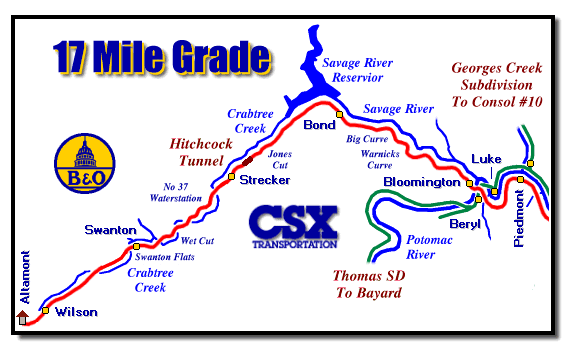
The grade steepens quickly past the wye with the 2% mark reached almost immediately before
the grade eases into a range hovering around 1.5% over the next mile to Wilson. As a
result of this sudden dropoff from the summit, eastbound trains will begin to make their
initial applications of the brakes as each tops the Deer Park Grade usually results in
trains practically creeping over the top. East of Wilson Seventeen Mile Grade begins to
contort into a series of almost never ending curves that will continue until Piedmont is
reached at the bottom. After a very short section of near level track, the Mountain
Subdivision begins to steepen further as the gradient increases to a range between 1.7%
and 2.29% until just west of Swanton, Maryland, at a location known to crews as the
"Swanton Flats". The "Flats" is a three fourth of a mile long section
of near tangent track that contains grades ranging from almost level to .5%. As a
consequence of this, eastbound trains which airbrakes have been applied too hard will
often be forced to apply power to pull the train through Swanton so that it will not stop.
However, the real trap is on the eastern side of Swanton where the grade immediately dips
to over 2% forcing engineers to have a careful hand when bringing their train across the
"Swanton Flats" - too much air and the train will stop, too little air and on
the far side down the Mountain she'll go. As for the town of Swanton, it served an
important role on the West End as an interlocking until the Era of Reconstruction forced
the plant to be moved farther east to Strecker. The West End continues to follow the
isolated Crabtree Creek valley from Swanton with the railroad crossing its namesake stream
no less than four times on several small bridges. Approximately three miles east of
Swanton is the timetable location of Stecker which at one time controlled the interlocking
at the eastern end of the third main track from Altamont. Strecker's HX Tower was closed
shortly after the end of the steam era, although during its day it helped weave trains and
helpers over the three and a half miles of double track between there and "BD"
Tower at Bond, the beginning of another triple track section of the West End. In 1997 a
runaway coal drag destroyed the old CPL Strecker signals, resulting in new SBD style
lights being installed several hundred feet further west near the old Number 37 Water
Station. 17 Mile Grade's only tunnel, the short 399.2 ft long Hitchcock Tunnel, is located
a short distance farther downhill which is actually more apt to be called a covered cut
due to its original excavation.
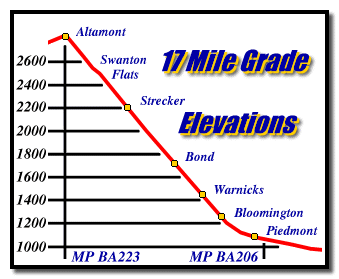
|
The railroad remains high above Crabtree Creek as the stream's valley deepens over the
next four miles with the railroad's grade ranging between just under 2% and 2.5% from the
eastern end of the previously mentioned "Swanton Flats". Near Crabtree Crossing
the Mountain Subdivision leaves the Crabtree valley and passes around the southern shore
of the large Savage River Reservior before following the Savage River Valley downhill to
Bloomington. Shortly to the east of the reservior's dam is the old location of
"BD" Tower at Bond, which at one time controlled both ends of a triple track
section between "BD" and Big Curve to the east. Bond was similar to Strecker in
the respect that both maintained interlockings while also controlling a steep runaway
track that was used by eastbounds descending Seventeen Mile if they were in danger of
running away or if they were already out of control as determined by a timing mechanism
between two set points. However, like Strecker, Bond was closed shortly into the steam era
and the runaway track removed, although its triple track section lasted into the early
1980s. East of Bond the Mountain Subdivision continues its descent of Backbone Mountain
passing through several large curves such as Big Curve, which remotelly controlled the
eastern end of the triple track section from Bond, and Warnicks Curve which contains one
of the steepest segments of 17 Mile Grade at 2.57%. Warnicks Curve was one of the
locations where a runaway coal drag derailed in February of 2000 leading CSX to install a
new defect detector inside the curve. From Warnicks the railroad continues down the
mountain passing through the small town of Bloomington, Maryland, which contains the
steepest gradient of 2.69% on the entire grade between Altamont and Piedmont. On the
downhill side of Bloomington the railroad crosses over the Potomac River and the CSX
Thomas Subdivision on a three arch viaduct at the West Virginia - Maryland state line. 17
Mile Grade begins to ease just past the WV State Rt 46 road bridge before swinging east
around the Beryl Wood Yard and Westvaco Plant at Luke. For the first time in almost
sixteen miles, the Mountain Subdivision enters a mile long section of track outside the
Piedmont Yard Limits that has a grade of less than 1%. Although this section between the
Yard Board and Milepost BA206 is still considered part of 17 Mile Grade, the maximum
gradient is little more than .5% that allows westbound trains requiring helpers to pull
past the Childs Avenue Xing in Piedmont so the helpers may couple on for the shove west.
Piedmont served as the base of helper operations on 17 Mile Grade during the early years
of the B&O, but the introduction of longer trains and better power resulted in this
operattion moved farther east to Keyser midway through the steam era.
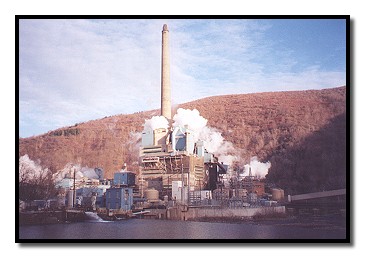 Photo by John Plishka. The huge Westvaco Wood Plant at Luke,
Maryland. This plant is a major source of traffic for the nearby Mountain Subdivision
which is worked by two daily turns out of West Virginia Central Junction. Photo by John Plishka. The huge Westvaco Wood Plant at Luke,
Maryland. This plant is a major source of traffic for the nearby Mountain Subdivision
which is worked by two daily turns out of West Virginia Central Junction.
|
The C&P Railroad also connected with the B&O in Piedmont until
1924 when the connecting bridge over the Potomac River between Piedmont and Westernport
was washed away, resulting in the Georges Creek line being worked via the Western Maryland
side of the Potomac ever since. Across from the old B&O station and depot in Piedmont
is the small three track Westvaco receiving yard that is most commonly used by Q316 to set
off or pick up cars from the Luke Switcher that works the large Westvaco Plant on a daily
basis. On the east side of the yard is a set of remotely controlled crossover switches
which allows trains to be ran on either main track between West Keyser to the east and
Mountain Lake Park. The 18480 ft long Eastbound Passing Siding between Piedmont and West
Keyser also diverges at the interlocking, although currently the western end of the siding
is out of service. The Mountain Subdivision's Interchange Track diverges on the south side
of the Piedmont interlocking providing access to the Westvaco receiving yard along with a
connection to the Thomas Subdivision at West Virginia Central Junction. This track is
reguarly used by the Luke Switchers moving between Luke and Keyser, along with the less
common Henry Turns destined for Bayard, West Virginia, or the Georges Creek Turns bound
for the Georges Creek Subdivision at Westernport, Maryland. A short distance east of the
Piedmont interlocking at Milepost BA206 is the official end of Seventeen Mile Grade after
a drop of more than 1700 feet or 100 feet per mile from Altamont - in all, an outstanding
segment of railroad. During this section the eastbound downgrade operations over 17 Mile
Grade have received most of the attention, although the westbound uphill ops should be
touched upon. Following the introduction of high powered diesel locomotives in the latter
part of the 20th century, helper operations used to push westbounds from West Keyser /
Piedmont up 17 Mile Grade to Altamont began to decline as freight traffic fell in the late
1970s. By the late 1990s, the Keyser Helper usually consisted of a single SD50 / 60 that
was rarely used on trains climbing Seventeen Mile as a result of CSX opting to move
westbound trains which were not heavy enough helpers - ie, restricting train length and
tonnage. When a Keyser Helper is required, the helper set will usually tie on at either
West Keyser or just west of the Childs Avenue Xing in Piedmont after the westbound train
has stopped just short of the Woodyard signals where the grade begins to steepen.

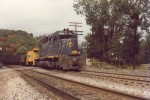 [Click
to enlarge] [Click
to enlarge]
Photo by Randy Strogen. In September of 1980, a lone B&O six axle is shoving
westbound empties up 17 Mile grade at Swanton, MD. Even twenty years ago, a single unit
helper had the power to shove empty hoppers back towards Grafton.
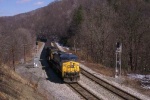 [Click
to enlarge] [Click
to enlarge]
Photo by Rich Borkowski Jr. A westbound empty train has just knocked down the
signal at No 37 Waterstation as it climbs Backbone Mountain. The seaboard style signals
are a replacement for a pair of B&O CPLs which were destroyed in a runaway derailment
in 1997.
 [Click to enlarge] [Click to enlarge]
Photo by Rich Borkowski Jr. Westbound CSX #43 bursts out of the west portal of
Hitchcock Tunnel on a winter day as it moves empty hoppers up 17 Mile Grade.
 [Click to enlarge] [Click to enlarge]
Photo by Terry Moore. In this view from the top of the east portal of Hitchcock
Tunnel, a fully powered Q317 with seven units on the front and the one unit Keyser Helper
shoving on the rear is grinding up the Crabtree Creek Valley on the morning of May 22nd,
1992.
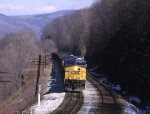 [Click to enlarge] [Click to enlarge]
Photo by Rich Borkowski Jr. CSX CW44AC #402 has the point of westbound empty
hoppers as the train approachs Hitchcock Tunnel. A steep embankment is directly to the
left of the train, marking the deep Crabtree Creek Valley.
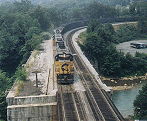 [Click to enlarge] [Click to enlarge]
Photo by Chris Strogen. Chessie System unit #6845 is about to cross into "Wild
Wonderful" West Virginia from the Maryland side of the Bloomington Viaduct in August
of 1988. The town of Bloomington can barely be seen in the background.
 [Click to
enlarge] [Click to
enlarge]
Photo by Rich Borkowski. The Luke Switcher with the classic CSX Chessie Cat, #2111,
is switching a string of Westvaco cars in the small Piedmont yard on a late summer day.
 [Click to enlarge] [Click to enlarge]
Photo by Chris Strogen. CSX #2111 is still in Chessie paint on December 29th, 1998,
as the lead units of the Luke Switcher pull their train off of the Mountain Subdivision's
main track and onto the Interchange at Piedmont, West Virginia.

An Eastbound drag releases two DTC blocks to the Dispatcher and receives an additional
block and yard limit down 17 Mile Grade to Piedmont, WV. DTC
Blocks on the Mountain


Original Web Page
http://www.wvrail.railfan.net/17mile_grade.html
Copyright 1998-2002 © Northern WV's Railroads
|